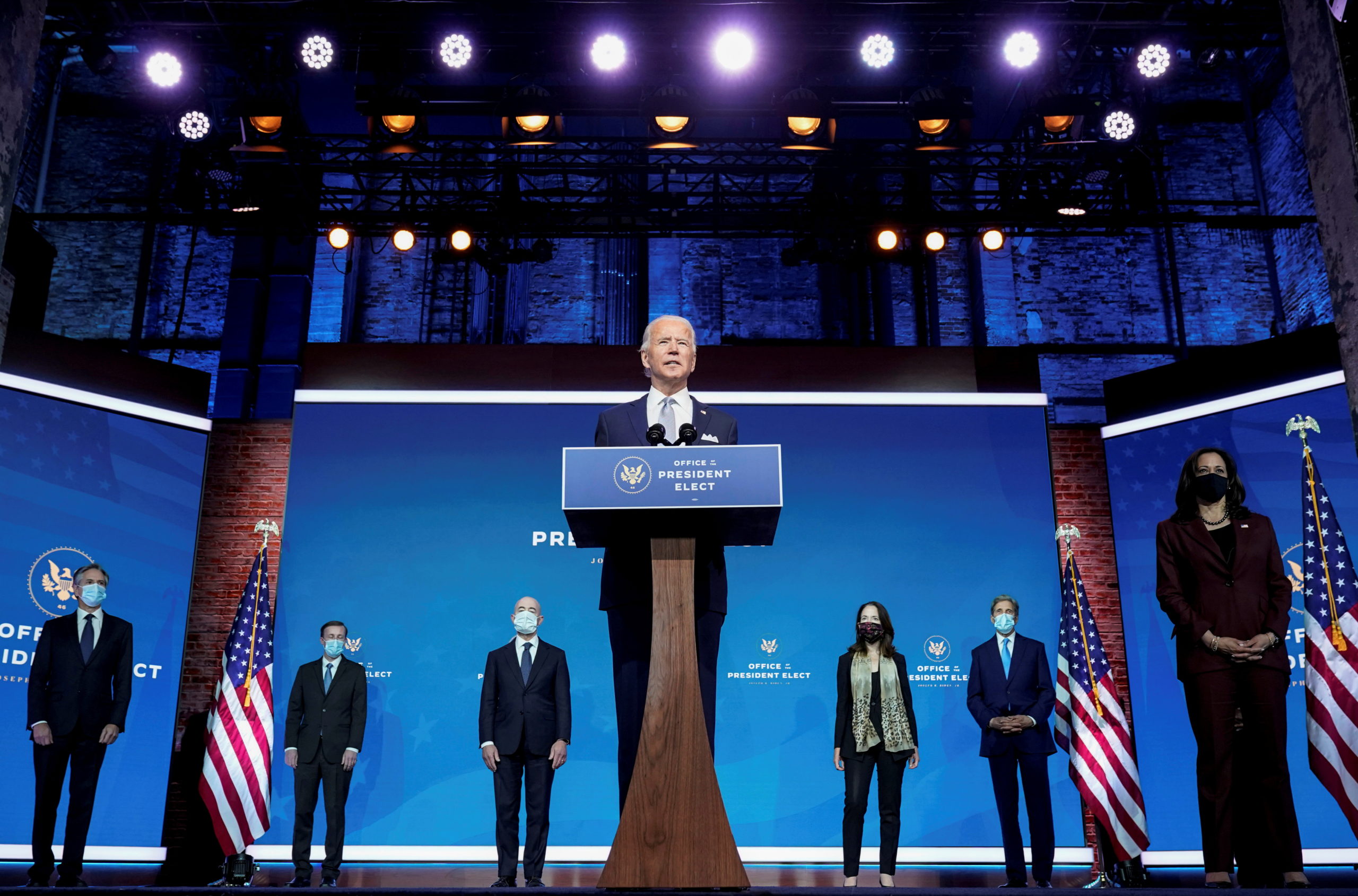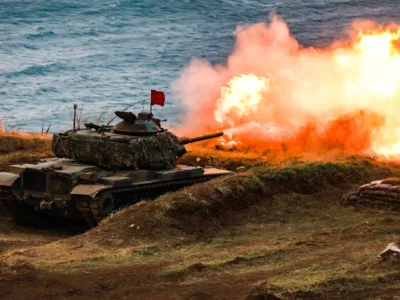A New Direction: A Foreign Policy Playbook on Military Restraint for the Biden Team
Introduction
Two decades of endless war and a bloated Pentagon budget that has proven useless in preventing Covid–19 deaths, now 270,000 and counting, are a jarring reminder that America’s foreign policy is thoroughly broken: It actually makes America and Americans less safe.
Successive administrations have deployed the military in a costly, counterproductive, and indiscriminate manner, normalizing war and treating armed dominance as an end in itself. In consequence, the foreign policies of the United States are detached from any defensible conception of U.S. interests and from a decent respect for the rights and dignity of humankind.
Marginal adjustments to the current approach will prove insufficient. A deeper rethinking of American foreign policy is warranted. This must be an undertaking that puts the well-being of the American people ahead of ambitions to dominate the globe.
President-elect Joe Biden appears to recognize the need for a serious reorientation. His just-named national security advisor, Jake Sullivan, recently said that Biden has tasked his foreign policy team with “reimagining our national security for the unprecedented combination of crises we face at home and abroad,” including pandemics and the climate crisis. Moreover, Sullivan said that American foreign policy has to be judged by a basic question: Does it “make life better, easier, and safer” for Americans at home? Our foreign policy, in Sullivan’s words, has to deliver for American families.
U.S. foreign policy exists to secure the safety and well-being of the American people while respecting the rights and dignity of all people.
We agree. And in that spirit, the Quincy Institute proposes an American foreign policy in line with the principles that guide our work: military restraint and responsible statecraft.
- Responsible statecraft serves the public interest: U.S. foreign policy exists to secure the safety and well-being of the American people while respecting the rights and dignity of all people. Foreign policy should therefore derive from serious consideration of the public interest and reflect the diversity of American society; to succeed, it can no longer be driven by the preferences of a narrow elite in Washington.
- Responsible statecraft engages the world: The United States should engage with the world, and the essence of engagement is peaceful cooperation among peoples — not war or domination.
- Responsible statecraft builds a peaceful world: The United States should respect established international laws and norms, discourage irresponsible and destabilizing actions by others, and seek to coexist with competitors. The United States need not seek military supremacy in all places, at all costs, for all time.
- Responsible statecraft abhors war: Any use of force should occur only as a last resort. The U.S. military exists to defend the people and territory of the United States, not to act as a global police force.
- Responsible statecraft is democratic: The American people have the right and responsibility to participate in the making of U.S. foreign policy, and Congress must fulfill its duties in the foreign policy sphere, neither tolerating the usurpation of its Constitutional role nor abdicating its authority to declare war.
This document spells out how the incoming Biden administration should embrace these principles in five specific contexts: China and East Asia, Afghanistan, the Greater Middle East, Saudi Arabia, and Iran. These fresh approaches will meet the challenge of reimagining our national security and ensuring that it delivers for the American people.
China & East Asia
Top-line recommendations
- Expand climate change and public health cooperation with China.
- Reduce military tensions in the Taiwan Strait and negotiate maritime agreements with China.
- Pursue peace and phased denuclearization on the Korean Peninsula.
- Restructure U.S. alliances in Asia around a denial-oriented defense strategy.
Strategic Outlook
The world is undergoing epochal change, and much of this change is driven by transformations in East Asia, especially the rise of China as a major military, economic, and technological power that challenges many U.S. interests but is not an existential threat. America’s strategy in East Asia must evolve to meet this moment. In recent years, the United States has doubled down on futile efforts to retain its past level of regional military dominance and stoked the fires of hostile ideological competition while neglecting robust diplomatic and economic engagement. Such efforts are dangerous and counterproductive.
The United States must instead foster an inclusive, stable order in East Asia designed to manage shared, top-priority challenges such as climate change and pandemics, to promote broad prosperity, and to peacefully resolve disputes. At the same time, to respond to China’s growing power and influence, the United States should work closely with allies to enhance their ability to defend themselves and bolster their resilience to economic coercion and undue political influence.
Recommendations
Expand climate change and public health cooperation with China
The United States must cooperate with China if the world is to make the transformational progress needed to confront the pressing threat of climate change. As the world’s two largest carbon emitters, they are uniquely positioned to mobilize international action. They should jointly lead in finding creative ways for the world to go beyond the Paris Agreement in reducing carbon emissions. One important form of such collaborative effort is to coordinate respective domestic targets and standards, such as in the area of clean transportation. The United States and China also must lead efforts to help the developing world adapt to climate change. They should jointly invest in affordable deep decarbonization technologies that can help the developing world pursue less carbon-intensive growth.
The United States must cooperate with China if the world is to make the transformational progress needed to confront the pressing threat of climate change. As the world’s two largest carbon emitters, they are uniquely positioned to mobilize international action.
Likewise, Washington should restore and expand its public health ties with China, redeploying experts from the Centers for Disease Control and the National Institutes of Health to Chinese cities and increasing information exchange and coordination with Beijing. The United States should also partner with China and other countries to help hard-hit developing nations recover from the pandemic and to bolster future pandemic preparedness.
Reduce military tensions in the Taiwan Strait and negotiate maritime agreements with China
Taiwan is the most likely source of conflict between the United States and China. The Biden administration should reduce U.S. military operations in the Taiwan Strait and explicitly reaffirm America’s commitment to its longstanding One China policy and an uncoerced, mutually acceptable resolution of the issue, eventually through cross–Strait negotiations. The United States should also continue to support Taiwan in developing a “porcupine strategy” for deterring China through investments in coastal defense and enhanced resilience. Beyond this balanced reassurance and deterrence, Washington should lay the groundwork for negotiations with Beijing, in coordination with Taipei, on paths toward reduced militarization of the Taiwan Strait.
In the maritime realm, the United States should pursue an agreement with China on safety in bilateral encounters at sea involving coast guard vessels — this to accompany standing bilateral agreements regarding naval and air force encounters. Washington should also negotiate an agreement with Beijing to lower military tensions in the South China Sea, whereby the United States reduces its close-in surveillance near Chinese naval bases and operations near disputed islands and reefs in exchange for affirmations as to freedom of navigation and the legal rights of military vessels at sea. It should also press China and other claimants to publicly reaffirm that they will not use force to dislodge rivals from any disputed land features.
Pursue peace and phased denuclearization on the Korean Peninsula
The United States must transition to a policy involving gradual, synchronized steps toward peace and the denuclearization of the Korean Peninsula. This must include security reassurances to North Korea as well as credible commitments to abide by agreements reached, which will require bipartisan congressional buy-in. Only on this basis will Pyongyang engage in meaningful negotiations, avoid provocative behavior, and be deterred from efforts to divide other participants in these agreements.
Realistically, even such positive developments are unlikely to cause Pyongyang to entirely relinquish its nuclear weapons. There are, however, near-term steps that the United States can make without jettisoning the long-term goal of a denuclearized Korean Peninsula. These include declaring the Korean War over, pursuing a peace treaty to be signed by signatories of the Korean War Armistice Agreement (the United States on behalf of the UN Command, North Korea, and China), limiting the size of North Korea’s nuclear force, discouraging the adoption of dangerous and destabilizing nuclear deployment strategies, and preventing the North from proliferating its capabilities to other nations or non-state actors.
Restructure U.S. alliances in Asia around a denial-oriented defense strategy
The United States should empower states in the region to do more for their own defense while restructuring the U.S. force posture in the region according to a more defensive, denial-oriented approach. Rather than seeking to exercise dominance or control in the western Pacific, the United States should instead aim to maintain the ability to deter offensive actions and deny efforts to control the air and seas by China or other nations.
As part of this effort, the United States should restructure its force posture in the region by reducing emphasis on forward-deployed ground troops, tactical aircraft, and large surface platforms, while increasing reliance on submarines, smaller surface ships, and long-range, standoff, anti-ship, and anti-aircraft conventional weapons delivery systems. The U.S. military should also prioritize increased dispersal of its forces in the region across a broader area with more strategic depth, rather than maintaining forces in highly concentrated forward locations.
Afghanistan
Top-line recommendations
- Withdraw all remaining U.S. troops.
- Adopt a global, partnership-driven counterterrorism strategy.
- Support transitional justice and sustainable aid models.
Strategic outlook
The war in Afghanistan began with the limited goal of targeting al–Qaeda’s operational capabilities following the 9/11 attacks. Two decades of mission creep later, it has morphed into the quintessential endless war. A complete military withdrawal best enables the United States to prioritize its own security objectives, support a negotiated power-sharing settlement in Afghanistan, and engage more productively with the region. Ending the longest active war in U.S. history will allow the United States to improve relations with countries that have been mired in the politics of this unwinnable conflict. Leaving this self-perpetuating war will free Washington to pursue other priorities in South and Central Asia, including trade, development, nuclear security, and climate change.
Calls to keep a residual special forces element in Afghanistan or condition a withdrawal on a negotiated settlement in a country with complex ethnic, religious, and tribal cleavages all but guarantees a reignition of U.S.–led combat operations. Any leverage the Afghan government gains by a continued U.S. troop presence is outweighed by the detrimental effect this security guarantee has on efforts to achieve a compromise. A withdrawal does not mean ceasing aid to the Afghan security forces as they assume full responsibility for securing their country, but the success or failure of a future settlement must fall on the shoulders of Afghans and function without U.S. troops. It is in the U.S. interest to complete the process of a full military withdrawal by May 2021, if not sooner.
Recommendations
Withdraw all remaining U.S. troops
Upon assuming office, the incoming administration should immediately coordinate with Defense Department planners to implement the withdrawal of all remaining U.S. troops no later than May 2021 in accordance with the U.S.–Taliban agreement signed in Doha in February 2020. A U.S. withdrawal should not hinge on the Taliban or Afghan government upholding their respective agreements with Washington — a move that would effectively give the Taliban and Kabul veto power over the United States acting in its own interest.
The incoming administration must reject calls to condition a U.S. withdrawal on factors that remain out of Washington’s control, such as an intra–Afghan peace deal. National consensus building and compromise has proved difficult to achieve in Afghanistan’s political system. The 2014 and 2019 presidential elections required closed-door mediation and a political settlement outside the scope of the electoral process. Therefore, while a negotiated political settlement remains Afghanistan’s best chance at achieving stability, it would be foolhardy for Washington to condition troop withdrawals on the outcome of this process.
The continued presence of U.S. troops encourages some Afghan leaders to oppose negotiations and disincentivizes cooperation among regional players, including China, India, Iran, Pakistan, and Russia. The Trump administration was wise to agree to unilateral talks with the Taliban to jumpstart intra–Afghan negotiations, but it wasted precious time by waiting until after the U.S. presidential election to begin the withdrawal of additional troops. The incoming administration should learn from this experience and commence an additional drawdown soon after taking office.
The war in Afghanistan began with the limited goal of targeting al–Qaeda’s operational capabilities following the 9/11 attacks. Two decades of mission creep later, it has morphed into the quintessential endless war.
The Biden administration should also resist calls to maintain a residual special forces presence in Afghanistan. Two decades of war led to an exaggerated perception of the terrorism threat that Afghanistan poses to American interests. The Taliban maintains links with al–Qaeda but lacks ambitions beyond Afghanistan’s borders. Furthermore, transnational terrorist groups such as al–Qaeda operate from numerous countries without a permanent U.S. military presence. Leaving U.S. special forces inside Afghanistan will provide minimal counterterrorism benefits and act as kindling for the revival of a flawed military approach to a conflict that requires a regional solution.
A military withdrawal does not mean an end to U.S. engagement in Afghanistan but rather a transition from a failing U.S.–led military strategy to one that prioritizes diplomacy and truly places Afghanistan’s future in the hands of Afghans.
Adopt a global, partnership-driven counterterrorism strategy
U.S. security will be better served by developing counterterrorism partnerships with stable nations that share similar terrorism concerns in the region, as opposed to indefinitely deploying U.S. troops to one hotspot after another in a hapless game of whack-a-mole. For example, Russia, China, Iran, and Pakistan share similar concerns about the rise of the ISIS offshoot known as the Islamic State–Khorasan Province, ISKP. But an open-ended, U.S.–led war in Afghanistan encourages regional actors to unilaterally pursue short-term agendas that further destabilize the country. The Biden administration should instead prioritize terrorism threats across the region and engage with potential tactical partners, including Iran, to address common threats together. This will require a sliding-scale approach to counterterrorism coordination that includes intelligence sharing and joint operations with trusted partners on one end, and backdoor diplomacy combined with confidence-building exercises on the other.
Support transitional justice and sustainable aid models
The United States should promote non-retributive transitional justice mechanisms to heal rather than divide Afghan society. These include truth commissions and victims’ compensation funds. It should condition future aid on basic human rights guarantees that are adopted nationwide rather than restricted to a Kabul bubble. The Biden administration must work with its traditional NATO allies to design a robust, multilateral aid framework that is channelled primarily through government institutions rather than NGOs and focused on efficiency and accountability. This framework should supplement Western aid with development projects led by Afghanistan’s immediate neighbors, including China and Iran. Most important, it is imperative that the next administration continue direct military aid to the Afghan security forces after a U.S. withdrawal.
Greater Middle East
Top-line recommendations
- Drawdown the U.S. military’s presence in the region.
- Support an inclusive security architecture.
- End the wars in Syria and Yemen, normalize relations with Iran.
- Lead by example on human rights.
Strategic outlook
The Middle East has dominated U.S. foreign policy for the past three decades, during which the region has become less and less important to U.S. strategic interests. Meanwhile, the costs of U.S. intervention in the region have not produced even remotely comparable benefits. The presence of the U.S. military in the Middle East makes America less safe by exacerbating instability, supporting dictatorship, and enabling more aggressive action by regional actors who assume they are protected by U.S. military supremacy.
All policies toward the region should derive from a careful and measured articulation of U.S. interests, rigorously defined. Moving forward, U.S. policy toward the Middle East should be guided by two core objectives: protect people in the United States from attack and facilitate the free flow of global commerce. Neither goal requires the current level of U.S. troop presence in the region, let alone regional military dominance. With this new approach the U.S. would not abandon the Middle East but would instead prioritize diplomatic and economic engagement over military assistance, arms sales, and intervention.
Recommendations
Drawdown the U.S. military’s presence in the region
The overwhelming U.S. military presence in the region is the result of inertia and outdated strategy, rather than a reflection of the region’s geopolitical value or a threat to the territorial U.S. Playing the role of regional military hegemon does not support U.S. interests; instead, it bows to the preferences of regional security partners that benefit from the presence of American troops.
U.S. interests would be better served by clearly signaling to its security partners that it will significantly withdraw troops over the next five to 10 years and use this period to help the region to establish its own security arrangements. The U.S. drawdown should not be tied to any stability milestones, as actors that benefit from the U.S. presence may try to generate insecurity in hopes of forcing the U.S. to stay.
The presence of the U.S. military in the Middle East makes America less safe by exacerbating instability, supporting dictatorship, and enabling more aggressive action by regional actors who assume they are protected by U.S. military supremacy.
Support the development of an inclusive security architecture
The U.S. must cease maintaining an artificial power balance predicated on a permanent U.S. military presence, military assistance, and massive arms sales. The U.S. should instead encourage the development of an inclusive regional security architecture. For such a structure to be sustainable, its development must be driven and led by regional actors, rather than the U.S.
Concerns about the region lacking ripeness for such an effort are valid. However, the lack of readiness and incentives for such an endeavor is directly tied to the U.S. military dominance of the region. U.S. security partners are disincentivized to develop a new security architecture and to pursue it in earnest so long as living under an American security umbrella remains an option. Only if the United States begins a military withdrawal from the Middle East and credibly signals it is disinterested in sustaining hegemony can the preconditions for the creation of a successful security architecture emerge.
End the wars in Syria and Yemen, normalize relations with Iran
America should be part of the solution in Syria and Yemen by taking part in efforts to find political settlements in these civil wars. In Syria, the U.S. should withdraw all troops, given that the original reason for their dispatch — to defeat ISIS — is now obsolete. The U.S. should declare a moratorium on arms sales to Saudi Arabia and the UAE until they cut off all support to parties to the Yemen conflict.
To enhance its diplomatic influence in the region, Washington’s policy toward the Middle East must entail active engagement with all players in the region — friends and foes alike.
To enhance its diplomatic influence in the region, Washington’s policy toward the Middle East must entail active engagement with all players in the region — friends and foes alike. Unfortunately, the U.S. has isolated itself from important players, effectively ceding diplomatic maneuverability, and with it the upper hand, to Russia and others. Consequently, the U.S. should seek to normalize relations with Iran and find constructive ways to manage differences with Tehran.
Lead by example on human rights
U.S. policy should reflect strong commitments to human and political rights in the Middle East while recognizing that military intervention cannot be the principal means of upholding those rights. U.S. policy must apply standards consistently to all parties in the region and must itself adhere to those same standards of human rights at home and abroad, for multilateral cooperation, and for international law.
Such consistency is not only right from a moral perspective; it is also congruent with U.S. interests. Human rights abuses have contributed to instability and violent extremism emanating from the Middle East. Research on the primary drivers of violent extremism often highlights the role of human rights abuses by state institutions. To be effective, America’s approach to human rights must be consistent, not selective. To condemn some states while giving others a pass demeans the concept of human rights, exposes the United States to charges of hypocrisy, and weakens America’s moral voice in the region and beyond.
Saudi Arabia
Top-line recommendations
- End the war on Yemen.
- Draw Saudi Arabia into a regional security architecture.
- Support development of nuclear energy for desalination.
- 4. End or limit weapons sales if Saudi Arabia undermines U.S. interests.
Strategic outlook
In the wake of the Cold War, the waning Global War on Terror, and the restructuring of the oil market, Saudi Arabia’s strategic importance to the U.S. has declined. Despite the mutual reliance that characterized earlier periods in the relationship and its transactional nature, Saudi policies occasionally undermined U.S. strategic interest. During the Cold War, Saudi Arabia harmed the U.S. economy by cutting oil supply and, later, propagating the spread of an intolerant version of Islam that fueled the spread of global terrorism. Exigencies of the Cold War and the Global War on Terror nevertheless impelled the U.S. to maintain close ties with Riyadh. Today, Saudi Arabia openly flouts U.S. interests by pursuing a destructive war in Yemen and an embargo of Qatar, while undercutting efforts to reduce U.S.–Iran tensions.
The current strategic justification for maintaining the bilateral status quo between the United States and Saudi Arabia is the cold war between the U.S. and Iran. The U.S. interest at stake, however, is in non-proliferation. Iranian compliance with the 2015 accord governing its nuclear programs through 2018 — a year after the U.S. withdrew from it — indicates that the threat of Iranian nuclear proliferation can be managed without Saudi military cooperation. When the Biden administration likely reenters the nuclear agreement, the U.S. will no longer be bound to tolerate Saudi subversion of U.S. interests.
Recommendations
End the War in Yemen
Saudi Arabia is waging a war in Yemen that is counter to a U.S. interest in regional stability. By pursuing its rivalry with Iran within an ongoing Yemeni civil war, Riyadh has triggered Houthi missile attacks against critical infrastructure in Saudi Arabia. If one of these strikes succeeds in inflicting serious damage, as nearly happened in an attack on the kingdom’s international airport in 2018, the pressure for U.S.–backed escalation would be difficult to resist. Saudi intervention in the Yemen conflict has also damaged U.S. interests in regional stability by creating a humanitarian crisis through attacks on civilian infrastructure and the targeting of noncombatants. These attacks are carried out with weapons systems and munitions supplied by the U.S. under its Foreign Military Sales program, thereby implicating the U.S. in war crimes. The United States should pressure Saudi Arabia to end the war, and the Biden administration should help facilitate peace negotiations.
When the Biden administration likely reenters the nuclear agreement, the U.S. will no longer be bound to tolerate Saudi subversion of U.S. interests.
Draw Saudi Arabia into a regional security architecture
Mistrust and long-running strategic competition between Saudi Arabia and Iran have led not only to the crisis in Yemen but also to devastating Iranian attacks on Aramco installations in Saudi Arabia and sporadic attacks, presumably by Iran, on Gulf shipping. These provocations were likely Tehran’s response to Saudi support for the Trump administration’s “maximum pressure” campaign against Iran, but they are also symptomatic of a broader historical pattern that precedes the Islamic revolution. It would be in the U.S. interest for this pattern to change. A less confrontational, more cooperative relationship would free the U.S. from its security role by stabilizing the Persian Gulf. As a first step, Saudi Arabia should cooperate with and contribute to efforts to establish a new multilateral framework, including Iran, for managing safety and security challenges in the Persian Gulf region.
Encourage a constructive regional role
To the extent that the Saudi leadership is seeking a regional role commensurate with the kingdom’s wealth and ambition, the U.S. could assist in making Saudi Arabia the linchpin of a regional effort to mitigate the destabilizing effect of global warming, which will hit the Gulf region especially hard. Washington’s support for Saudi Arabia’s quest for civilian nuclear power could enable the kingdom to power desalination plants in neighboring countries that lack the resources to desalinate seawater on a large scale.
Curtail arms sales
If the kingdom were to continue to disregard or actively undermine U.S. regional interests, Washington could shift to a policy of disincentives. These would center on ending arms sales until the Saudis desist from actions that run counter to U.S. interest. Apart from Iran, the kingdom does not currently fear any natural predators. If, under the incoming administration, U.S.–Iran ties were stabilized, the Iranian threat so clearly displayed in the 2019 Aramco strikes would be reduced. Cutting off the sale of U.S. weapons systems to Saudi Arabia would not fundamentally endanger the Kingdom’s security. It would signal clear U.S. dissatisfaction with the effects of Saudi policies and counter perceptions of U.S. complicity or support for Saudi actions that are strategically dangerous or raise humanitarian concerns.
Iran
Top-line recommendations
- Swiftly return to the JCPOA.
- After “maximum pressure,” offer humanitarian assistance.
- Pursue an end to U.S.–Iran enmity.
- Address regional concerns through a new security architecture.
Strategic outlook
The prevailing policy of isolating Iran lacks a strategic rationale and has failed on all fronts. It fuels tensions in the Middle East and leaves the United States and Iran perpetually on the verge of military confrontation. While Iran poses a challenge to several U.S. interests, the experience of the past four decades demonstrates that the U.S. has succeeded in changing core Iranian national security policies only through multilateral diplomacy. Neither threats of war nor sanctions and “maximum pressure” have achieved what direct diplomacy secured in the negotiations that produced the Joint Comprehensive Plan of Action in 2015.
But the experience of the past few years has also shown that the JCPOA alone is insufficient: The agreement cannot endure if the broader relationship between the United States and Iran continues to be characterized by belligerent enmity.
President Joe Biden should take the opportunity presented by a new administration to think bigger. Instead of asking himself what degree of sanctions relief he is willing to fight for in Congress to revive the nuclear agreement, he should ask himself what kind of relationship the United States should have with Iran in this century. If being trapped in unending enmity no longer serves U.S. interests and instead makes the country less safe at a time when the public wants an end to wars and a withdrawal of forces from the Middle East, then Biden must think beyond the nuclear deal.
Recommendations
Swiftly return to the JCPOA
President Biden will have a short window of roughly four months to revive the JCPOA, due to Iran’s presidential elections in June 2021. Biden should immediately take concrete steps to prepare the ground for the resurrection of the nuclear deal and broader diplomacy with Iran. Specifically, Biden should clearly signal that he will bring the U.S. swiftly (i.e., before June 2021) into comprehensive compliance with the JCPOA, both in letter and spirit, provided Tehran does the same. Biden should not seek to renegotiate the JCPOA using Trump’s sanctions as some illusionary leverage. Any hint that Biden effectively seeks to continue Trump’s maximum pressure strategy will prompt the Iranians to aggressively expand their nuclear program to develop their own leverage, which will promptly close the window for a JCPOA revival — much to the detriment of U.S. national security.
If being trapped in unending enmity with Iran no longer serves U.S. interests and instead makes the country less safe at a time when the public wants an end to wars and a withdrawal of forces from the Middle East, then Biden must think beyond the nuclear deal.
After “maximum pressure,” offer humanitarian assistance
After the Obama administration’s careful efforts to resolve the nuclear issue and put U.S.–Iran relations on a better footing — including renewing people-to-people exchanges and opportunities for American and Iranian civil societies to connect and collaborate — the Trump administration reversed those gains and imposed pressures on Iran that seemingly were aimed at directly targeting the Iranian civilian population. The Trump administration even intensified sanctions in the midst of the Covid–19 pandemic, including sanctioning the last remaining Iranian banks that conducted trade in food and medicine.
President Biden should swiftly reverse this negative trajectory by making a humanitarian gesture toward the people of Iran. For instance, he can remove U.S. opposition to Iran’s long-pending request to the International Monetary Fund for a $5 billion emergency loan to fight the coronavirus pandemic. The U.S. and Iran have been two of the countries hardest hit by the virus, and U.S. sanctions have made the virus all the more deadly in Iran’s case. From a moral and humanitarian standpoint, opposing aid to help fight Covid–19 is simply indefensible.
Pursue an end to U.S.–Iran enmity
Repairing the broader relationship with Tehran will take time and patience. As a first step, Biden should clearly signal his intent to establish constructive ties with Iran and float the idea of normalizing relations. Such a step would not cost the United States leverage or enable Iran to pocket a concession. On the contrary, declaring the intent is crucial to create enough confidence and trust to find constructive ways to manage America’s differences with Iran. Indeed, establishing diplomatic relations is neither a gift nor a capitulation to Tehran. Rather, it is a much-needed measure to maximize America’s leverage.
Address regional concerns through a new security architecture
Once the JCPOA has been restored, the United States should address concerns about Iran’s non-nuclear policies through renewed multilateral negotiations. However, Iran’s regional conduct is best addressed within a broader discussion about regional security, with the aim of establishing a new security architecture for the Persian Gulf. Iran’s ballistic missiles or its role in Syria, for instance, cannot be effectively resolved without also addressing Saudi and Emirati military spending or their involvement in conflicts throughout the region. The Biden administration can make a significant contribution to both U.S. security and regional stability by promoting such a regional dialogue between the countries of the Persian Gulf. While the Biden administration can, and may have to, convene the first summit to kick-start regional diplomacy, it should swiftly hand over ownership and leadership of the initiative to regional actors themselves.












